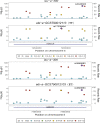Association between genetically proxied HMGCR inhibition and male reproductive health: A Mendelian randomization study
- PMID: 37773823
- PMCID: PMC10545124
- DOI: 10.1097/MD.0000000000034690
Association between genetically proxied HMGCR inhibition and male reproductive health: A Mendelian randomization study
Abstract
Background: The causal associations between statin use and male sex hormone levels and related disorders have not been fully understood. In this study, we employed Mendelian randomization for the first time to investigate these associations.
Methods: In two-sample Mendelian randomization framework, genetic proxies for hydroxy-3-methylglutaryl-coenzyme A reductase (HMGCR) inhibition were identified as variants in the HMGCR gene that were associated with both levels of gene expression and low density lipoprotein cholesterol (LDL-C). We assessed the causal relationship between HMGCR inhibitor and 5 sex hormone levels/2 male-related diseases. Additionally, we investigated the association between 4 circulating lipid traits and outcomes. The "inverse variance weighting" method was used as the primary approach, and we assessed for potential heterogeneity and pleiotropy. In a secondary analysis, we revalidated the impact of HMGCR on 7 major outcomes using the summary-data-based Mendelian randomization method.
Results: Our study found a significant causal association between genetic proxies for HMGCR inhibitor and decreased levels of total testosterone (TT) (LDL-C per standard deviation = 38.7mg/dL, effect = -0.20, 95% confidence interval [CI] = -0.25 to -0.15) and bioavailable testosterone (BT) (effect = -0.15, 95% CI = -0.21 to -0.10). Obesity-related factors were found to mediate this association. Furthermore, the inhibitor were found to mediate a reduced risk of prostate cancer (odds ratio = 0.81, 95%CI = 0.7-0.93) by lowering bioavailable testosterone levels, without increasing the risk of erectile dysfunction (P = .17). On the other hand, there was a causal association between increased levels of LDL-C, total cholesterol, triglycerides (TG) and decreased levels of TT, sex hormone-binding globulin, and estradiol.
Conclusions: The use of HMGCR inhibitor will reduce testosterone levels and the risk of prostate cancer without the side effect of erectile dysfunction. LDL-C, total cholesterol, and TG levels were protective factors for TT, sex hormone-binding globulin, and estradiol.
Copyright © 2023 the Author(s). Published by Wolters Kluwer Health, Inc.
Conflict of interest statement
The authors have no conflicts of interest to disclose.
Figures





Similar articles
-
Mendelian randomization analyses identified bioavailable testosterone mediates the effect of sex hormone-binding globulin on prostate cancer.Andrology. 2023 Sep;11(6):1023-1030. doi: 10.1111/andr.13358. Epub 2023 Jan 12. Andrology. 2023. PMID: 36524281
-
Genetic association of lipid-lowering drugs with aortic aneurysms: a Mendelian randomization study.Eur J Prev Cardiol. 2024 Jul 23;31(9):1132-1140. doi: 10.1093/eurjpc/zwae044. Eur J Prev Cardiol. 2024. PMID: 38302118
-
Association between genetically proxied PCSK9 inhibition and prostate cancer risk: A Mendelian randomisation study.PLoS Med. 2023 Jan 3;20(1):e1003988. doi: 10.1371/journal.pmed.1003988. eCollection 2023 Jan. PLoS Med. 2023. PMID: 36595504 Free PMC article.
-
Using genetic variants to evaluate the causal effect of cholesterol lowering on head and neck cancer risk: A Mendelian randomization study.PLoS Genet. 2021 Apr 22;17(4):e1009525. doi: 10.1371/journal.pgen.1009525. eCollection 2021 Apr. PLoS Genet. 2021. PMID: 33886544 Free PMC article.
-
The role of HMGCR alternative splicing in statin efficacy.Trends Cardiovasc Med. 2009 Jul;19(5):173-7. doi: 10.1016/j.tcm.2009.10.003. Trends Cardiovasc Med. 2009. PMID: 20005478 Free PMC article. Review.
Cited by
-
Lipids, lipid-modified drug target genes, and the risk of male infertility: a Mendelian randomization study.Front Endocrinol (Lausanne). 2024 Jul 24;15:1392533. doi: 10.3389/fendo.2024.1392533. eCollection 2024. Front Endocrinol (Lausanne). 2024. PMID: 39114294 Free PMC article.
References
-
- Morgentaler A, Traish A, Hackett G, et al. . Diagnosis and treatment of testosterone deficiency: updated recommendations from the Lisbon 2018 International Consultation for Sexual Medicine. Sex Med Rev 2019;7:636–49. - PubMed
-
- Najari BB, Kashanian JA. Erectile dysfunction. JAMA. 2016;316:1838. - PubMed
MeSH terms
Substances
LinkOut - more resources
Full Text Sources
Medical
Miscellaneous

